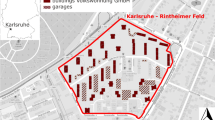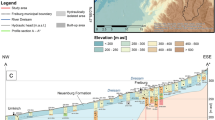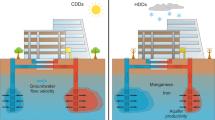Abstract
All metropolis across the world are facing the challenges of the growing energy demand and the need to reduce the CO2 emissions. In order to match the two constraints, urban environments should diversify energy sources and maximize local opportunities offered by renewable resources. Within this context, water resources and especially groundwater represent potential alternatives that could provide an efficient answer to the development needs. Nice Côte d'Azur Metropolis gathers around 540,000 inhabitants with more than 350,000 for the city of Nice. Within a national strategic project, the metropolis is currently develo** a new urban environment located within the low valley of the Var river and has decided to establish a multi-energy Smart Grid solution. The innovative technological approach is based on: storage of heat, production of cold and electricity, and also a cooling offer for individuals, resulting from the recovery of energy used to air-condition commercial buildings. The chosen solution is based on thermal use of the shallow unconfined aquifer located with the Var floodplain. The network is using surface geothermal energy from the alluvial aquifer. By 2029, it will cover the heating (7.2 GWh per year), air conditioning (15.5 GWh per year) and domestic hot water (7.5 GWh per year) needs of 520,000 m2 of housing, hotels and additional residential facilities, shops, services and offices served by 1.6 km of geothermal network, 5.6 km of hot and cold networks and 94 sub-stations. The Nice Méridia area will thus be supplied by 82% renewable and recovered energy for heating and 78% for cooling. The development of the geothermal solution requests to pump and to reinject important volumes within the unconfined aquifer. In order to assess the potential impact of the solution on the existing uses (drinking water supply pum** stations), a 3D modelling approach has been deployed over the full groundwater resource of the Var valley. The model, built with FEFLOW solution, validated with field observation, can reproduce the behavior of the aquifer (flow dynamic and thermal). The results have demonstrated the efficiency of the 3D modelling approach and the possibility to use the geothermal resource without significant impact on the aquifer. The thermal use of the shallow unconfined aquifer represents a promising solution that could be duplicated in other locations where similar aquifers are present.
Access this chapter
Tax calculation will be finalised at checkout
Purchases are for personal use only
Similar content being viewed by others
References
Du M, Zavattero E, Ma Q, Gourbesville P, Delestre O (2018) Groundwater modeling for a decision support system: the lower Var Valley, Southeastern France. Adv Hydroinform, pp 273–283
Du M, Zavattero E, Ma Q, Delestre O, Gourbesville P, Fouché O (2018) 3D modeling of a complex alluvial aquifer for efficient management–application to the lower valley of Var river France. La Houille Blanche 1:60–69
Guglielmi Y (1993) Hydrogéologie des aquifères Plio‑Quaternaires de la basse vallée du Var, PhD thesis, Université d’Avignon et des Pays du Vaucluse, France
Potot C (2011) Etude hydrochimique du système aquifère de la basse vallée du Var, apport des éléments traces et des isotopes (Sr, Pb, δ18O, 226, 228Ra). PhD thesis. Université Nice Sophia Antipolis, France
Diersch HJ, Kolditz O (1998) Coupled groundwater flow and transport: 2. Thermohaline and 3D convection systems. Adv Water Resources 21(5):401–425
Diersch HJ (2005) Feflow: finite element subsurface flow and transport simulation system. Reference manual. WASY GmbH, Berlin
Zhao C, Wang Y, Chen X, Li B (2005) Simulation of the effects of groundwater level on vegetation change by combining Feflow software. Ecol Model 187:341–351
Ashraf A, AhmaMAd Z (2008) Regional groundwater flow modelling of Upper Chaj Doab of Indus Basin, Pakistan using finite element model (Feflow) and geoinformatics. Geophys J Int 173:17–24
Gaultier G, Boisson M, Canaleta B (2012) Geothermal modeling at city district level for optimized groundwater management. In: 3rd International Feflow user conference, Berlin
Gourbesville P (2008) Integrated river basin management, ICT and DSS: challenges and needs. Phys Chem Earth 33(5):312–321
Guinot V, Gourbesville P (2003) Calibration of physically based models: back to basics? J Hydroinf 5:233–244
Acknowledgements
The current research was jointly funded by Nice Côte d’Azur Métropolis and Université Côte d’Azur with the support of the Rhone Méditerranée Water Agency under the framework of the AquaVar project. The authors would like to thank all representatives managing services who have supported the research with data and field expertise.
Author information
Authors and Affiliations
Corresponding author
Editor information
Editors and Affiliations
Rights and permissions
Copyright information
© 2022 The Author(s), under exclusive license to Springer Nature Singapore Pte Ltd.
About this paper
Cite this paper
Gourbesville, P., Ghulami, M. (2022). Assessment of Smart Heating and Cooling System Based on Thermal Use of Shallow Aquifer. In: Gourbesville, P., Caignaert, G. (eds) Advances in Hydroinformatics. Springer Water. Springer, Singapore. https://doi.org/10.1007/978-981-19-1600-7_64
Download citation
DOI: https://doi.org/10.1007/978-981-19-1600-7_64
Published:
Publisher Name: Springer, Singapore
Print ISBN: 978-981-19-1599-4
Online ISBN: 978-981-19-1600-7
eBook Packages: Earth and Environmental ScienceEarth and Environmental Science (R0)




